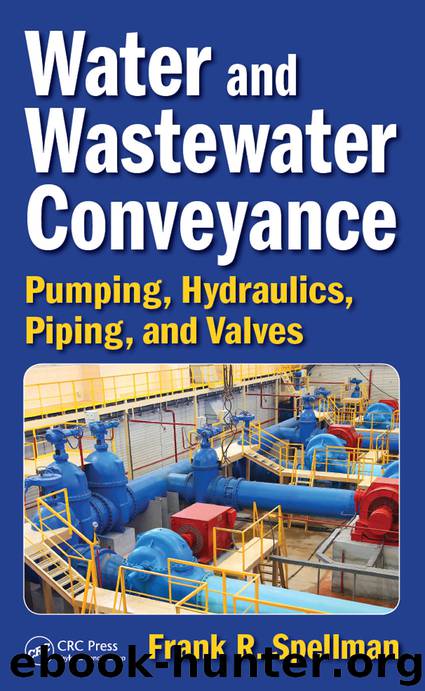Water and Wastewater Conveyance by Frank R. Spellman

Author:Frank R. Spellman
Language: eng
Format: epub
Publisher: CRC Press
TRANSPORT OF SEWER SOLIDS
Sewer flow-carrying velocities for solid-phase matter were first evaluated at a sewer pilot system in 1967 (FMC, 1967a). Results indicated that the flow velocity for resuspension of the settled solids was much greater than the flow velocity in which solids would settle (i.e., solids resuspension ≥ 0.44 m/s [1.44 ft/s] vs. solids settling < 0.27 m/s [0.88 ft/s]). Microscopic examination of the sewer sediment samples collected from the test pilot sewer line found sand-like particles with a size range of 40 to 900 µm with a specific gravity range of 2.4 to 2.6. These particles required the highest flow velocity to be resuspended from the bottom of the test sewer line. Another investigation was conducted to determine the settling characteristics (including size and specific gravity distributions) of solids in sanitary wastewater, CSO, and stormwater runoff (Dalrymple et al., 1975). The settling velocity distributions for road dust (10 to 20 µm) and wastewater solids (74 to 149 µm) appeared to relate to Stokes’ law for spherical particles at these size ranges. According to Stokes’ law, for Reynolds numbers (Re) < 1, particle settling velocity (vs) can be expressed as
Download
This site does not store any files on its server. We only index and link to content provided by other sites. Please contact the content providers to delete copyright contents if any and email us, we'll remove relevant links or contents immediately.
| Automotive | Engineering |
| Transportation |
Whiskies Galore by Ian Buxton(41544)
Introduction to Aircraft Design (Cambridge Aerospace Series) by John P. Fielding(32893)
Small Unmanned Fixed-wing Aircraft Design by Andrew J. Keane Andras Sobester James P. Scanlan & András Sóbester & James P. Scanlan(32581)
Craft Beer for the Homebrewer by Michael Agnew(17940)
Turbulence by E. J. Noyes(7720)
The Complete Stick Figure Physics Tutorials by Allen Sarah(7151)
Kaplan MCAT General Chemistry Review by Kaplan(6606)
The Thirst by Nesbo Jo(6452)
Bad Blood by John Carreyrou(6286)
Modelling of Convective Heat and Mass Transfer in Rotating Flows by Igor V. Shevchuk(6232)
Learning SQL by Alan Beaulieu(6045)
Weapons of Math Destruction by Cathy O'Neil(5854)
Man-made Catastrophes and Risk Information Concealment by Dmitry Chernov & Didier Sornette(5674)
Digital Minimalism by Cal Newport;(5398)
Life 3.0: Being Human in the Age of Artificial Intelligence by Tegmark Max(5199)
iGen by Jean M. Twenge(5171)
Secrets of Antigravity Propulsion: Tesla, UFOs, and Classified Aerospace Technology by Ph.D. Paul A. Laviolette(5014)
Design of Trajectory Optimization Approach for Space Maneuver Vehicle Skip Entry Problems by Runqi Chai & Al Savvaris & Antonios Tsourdos & Senchun Chai(4849)
Electronic Devices & Circuits by Jacob Millman & Christos C. Halkias(4760)
